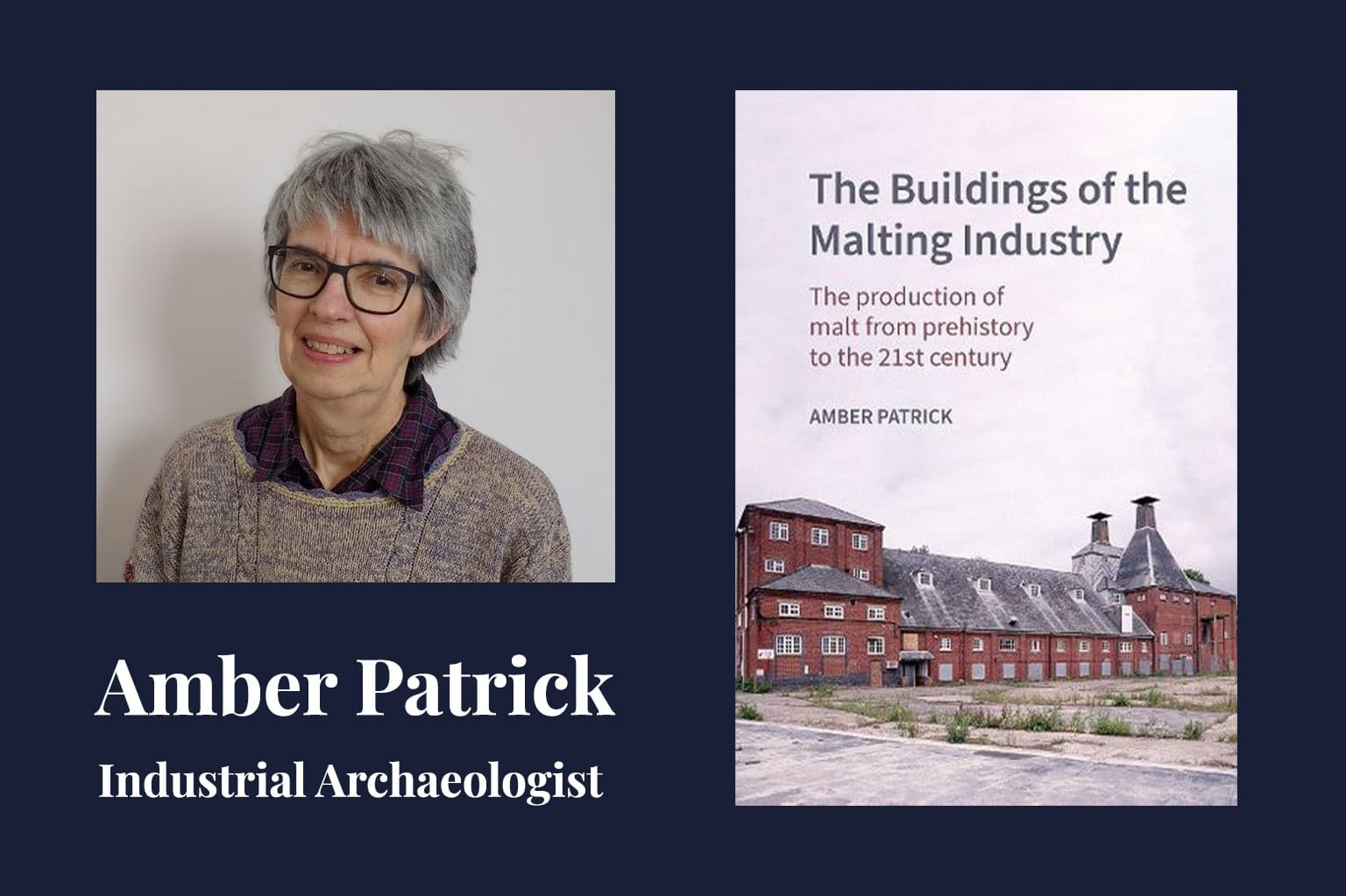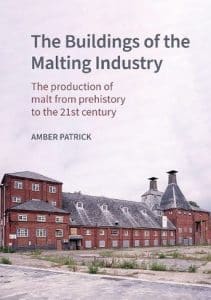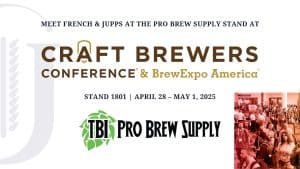Introduction
French and Jupps are the oldest family-owned malting company in Britain still producing malt. Initially the company was just operated by the Jupp family as it still is today. The French element of the company did not join until 1867 or perhaps slightly earlier and they did not continue in the business for long. Originally, like all malting companies, Jupps were traditional floor maltsters, but today they only produce coloured and specialist malts using germinating drums, and specialist roasting drums.
History – Starting at Brentford
The earliest identifiable Jupp maltings were in Brentford. William Jupp, born in Horsham, West Sussex in 1771 was established in Brentford by the late 1790s, according to details of his marriage to Rebecca Bax in 1798. In 1802 there is the first reference to his malthouse in Ferry Lane, Brentford. There is a reference to this malthouse as early as the 1780s when it was owned by a Richard Thorogood but occupied by a Mr Wallace. It was from Mr Wallace that William Jupp took over the malthouse. This malthouse was to remain part of their business until at least 1901 and the Ordnance Survey large scale maps of 1893 shows that it was a large building.
The Jupp family had no obvious connection with Brentford, but the town on the north bank of the Thames already had a thriving corn market. This had resulted in the establishment of malting and brewing industries and a survey taken between 1790 and 1795 noted that there were four malthouses. Brentford was also to be the Grand Junction (subsequently Grand Union) Canal’s terminus on the Thames. So a town which already had docks and wharves was likely to be a good location to expand a maltings business as well as for trade in coal, corn and hay, all of which became part of the Jupp’s business interests. The canal was fully opened to Brentford in 1800. As a result there was access to and from the Midlands and of course down the Thames to the London brewing market for malt.
William had three children who were involved in the malting industry to a greater or lesser extent: William born 1798/9, Charles born 1804 and Henry born 1806. The firm was soon trading as William Jupp and Son(s). It was to be William Jupp the younger who continued the malting business with Henry probably more engaged in farming. However, it was not long before William Jupp senior (died1852) and later his son had expanded the number of maltings in Brentford, probably by the late 1820s, with the addition of malthouses behind Nos 84 & 85 the High Street, which also gave access to Jupps Wharf. The wharf is named on the Ordnance Survey 25 Inch Map revision of 1893, but by the time of the next revision in 1912 it was no longer named after the Jupps. The Jupps were also corn, cake, hay, salt and coal merchants and these activities appear to have outlasted the production of malt in Brentford, and they retained offices for these aspects of their business until c. 1940. Their Ferry Lane Malthouse had been demolished by the time of the Ordnance Survey 25 Inch map 1935 revision.
Expansion eastwards along the Thames
William Jupp expanded his malthouse holdings with the addition of a malthouse adjacent to Kew Bridge – on the Brentford Middlesex side of the Thames and the western side of the bridge. A photograph of c. 1892 shows its kiln cowl. This malthouse was shown on the Ordnance Survey 25 Inch map 1891 revision but had gone by the 1912 revision. There was further expansion with a least one malthouse, No 45, at Strand on the Green, Chiswick and so further east along the Thames towards central London. This was acquired through William Jupp, the younger marrying Elizabeth Saunders in 1826. She was the daughter of Charles Saunders who had inherited the maltings from his father John Saunders. This malthouse was referred to as the Blue Malthouse and a drawing of 1908 shows it with a barge in front. The Jupps probably owned about five Thames sailing barges which would have brought in barley and taken their malt up the Thames to the London breweries or perhaps only as far as Fuller’s Griffin Brewery in Chiswick. The last two of the Jupp’s barges were the George and the Jane. The younger William Jupp (died 1871) also had a son named William (born 1827) and three other sons who were instrumental in the maltings business: Alfred born 1828, David born in 1838 and George Harman born in 1845.
Alfred continued the Jupp malting business in Brentford as did his brother George Harman who was also a county councillor for Brentford West and a noted sportsman in particular in cricket.
Further expansion with the younger generation
David was also listed as a maltster, and in 1862 married Ann Holroyd the daughter of James Holroyd, miller, of Byfleet, Surrey. He was also a farmer and landowner. It is perhaps worth noting that a George Barron Holroyd is listed a brewer in Byfleet in an 1878 trade directory. David had seven children: four daughters: Ruth, Adeline, Emma and Katharine Agnes, and three sons: Ernest, Harold and Claude (born 1879).
Starting to move out of London
In 1864 the Jupps bought at auction a freehold malthouse in Stanstead Abbots. This was a floor maltings and the sale notice indicates that it had a steeping capacity of 56 quarters every eight days. It had a wharf on the navigable river Lea. This meant that the malt produced could easily be shipped down to London by barge. It was also with 200 yards of St Margarets Station which would also have provided direct access to London’s Liverpool Street station.
As well as a move into London
By 1867 the firm of Jupp, probably at the instigation of David Jupp, had joined with French and from then on that branch of the firm was known at French and Jupps. Besides the maltings in Stanstead Abbots and Brentford, the alliance with French resulted in the acquisition of the roasting plant at Cox Square, Spitalfields, London. It may have been acquired from a Mrs M Backhouse who was listed as a maltster there until about 1862. This was an ideal location because of its proximity to the Liverpool Street station and therefore the malt produced at Stanstead Abbots. Roasted malt or patent malt was at this date governed by the Roasted Malt Act (5 Vic c 30 (1842)). This provided that only those who were licensed could make roasted malt. There were strict regulations as to the site of the premises and not that many could comply with these, so not many entered the business. Of course this made such production more or less a monopoly, and therefore profitable for those so licensed. This would have been an important strategic move by French and Jupps. (The Act was only repealed when the Malt Tax was repealed in 1880.)
There was a deed of partnership two years later, 1869 which shows William Jupp setting up in partnership with two of his sons, Joseph (born 1840) of Brentford and David who is listed as of Hampton Wick (Richmond, Surrey). The partnership was dissolved in 1882. Certainly by the last decades of the 19th century malting in Brentford was probably on the decline. Also of course the Malt Tax and the roasted Malt Act had been repealed in 1880. Both of these may have prompted the dissolution of the partnership.
Then in 1889 David Jupp purchased the maltings of H. A. & D. Taylor in Stanstead Abbots. Some of the buildings dated to the mid-18th century. These maltings included a malt roasting plant as well as floor malting. The malt roasting plant was behind the Jolly Fisherman and therefore conveniently located for St Margarets Station and its goods sidings. It was steam driven until 1947. The drums were heated by coke produced as a by-product of Beckton Gasworks. The plant remained in use until destroyed by a dust fire in 1963.
Into the 20th century in Stanstead Abbots
Then in 1902 the malt roasting factory at Cox’s Square was closed and from then on all roasting was done at Stanstead Abbots. French and Jupps retained an office in London and their title was Patent Maltsters, 45 Devonshire Chambers, Bishopsgate, EC. This was retained until 1939.
Although the Jupps still had a London Office and were still in business in Brentford, there is little evidence that they remained producing malt there. In contrast malt production and the acquisition of plant continued in Stanstead Abbots. Further maltings were acquired from 1890 onwards and in particular in 1899 No 4 Malthouse was purchased from Henry Taylor.
Then land off Roydon Road was also purchased. The brown malting was built at the south western end of the main site. It had a round kiln with a tall rotating cowl. This type of kiln was typical of those used in brown malt production. A new and taller maltings was built to the east of Malthouse No 3 in the same year. However, not all was plain sailing as in 1901 the rented brown maltings burnt down.
There was a major event in 1920 when the company of French and Jupps was registered with David Jupp and his son Claude being listed as directors, and shortly afterwards Emma Jupp was also made a director. However only a few years later, the death of David Jupp was reported He died on 30 November 1925 and his address was given as Brook Lea, Church Moor Avenue, Esher, Surrey, and it was noted that he was the Chairman of French & Jupps, 43 Devonshire Chambers, Bishopsgate, EC died aged 87. With David’s death Claude became managing director. Like George Harman he too was a sportsman.
From the early 1920s there were a number of changes and improvements to the various malthouse plants in Stanstead Abbots. These included in 1922 the purchase of a Boby crystal malt cleaning plant, and in 1923 a specific crystal malt store was built. In 1928 Malthouse No 1 was demolished, but in 1929 two Bryan Corcoran cylinders were installed, and a further two in 1931, and another two large ones were bought in 1933 and 1934 respectively. All these cylinders were installed in the roasting plant behind the Jolly Fisherman. The size of the two large drums resulted in the need for more substantial foundations. Electric light was installed in 1926. and by 1937 a gas plant was bought.
The Second World War and after
The closure of the London office in 1939 meant that the business address was initially moved to the office in Stanstead Abbots. Then in 1943 and perhaps rather surprisingly the registered office of French and Jupps moved to 6 Great Winchester Street, London EC2. Inevitably there were problems during the War. In 1940 the Ministry of Food took over the Brown Malthouse. There were labour shortages when men signed up but this was partially solved with Irish maltsters from Guinness. Then there were problems with supplies, in particular coal (coke/anthracite) for kilning.
In 1946 Ronald David (Ronnie) Jupp became a director and a year later company secretary. In 1949 Emma Jupp died and Guy Horlock joined, and in 1956 became a director. In 1968 Ronnie Jupp took over the chairmanship of the company from his father Claude (died in in 1968). In 1992 Ronnie Jupp transferred the managing directorship to Guy Horlock who retired as chairman in 2011. David Jupp became managing director, the fifth generation. He retired in 2020 and became chairman.
After the war works continued on the various sites, including the installation of a hard core road in 1947 and in the following year an office on Roydon Road. There were further changes from the 1950s onwards. 1954 saw the NH Malting being converted for producing white malt as well as a new Robinson’s dresser, but probably the most important change was the firing of the kiln from coke/anthracite to oil. In 1960 there was a fire at the St Margarets Roasting factory. 1966 saw the start of the closure of the production of white malt and a concentration on the production of coloured malts. In 1968 a start was made on the industrial units. Changes continued in the 1970s with closure of the NH maltings and the drum malting plant starting up. However, it was not until 1974 that floor malting finally ceased, and in that year a germinating drum was purchased from Lacon’s Brewery Maltings in Great Yarmouth, Norfolk.
In 1986 the first Bath roasting drum was installed. 1987 saw a fire in the drum malting. (The hazard of fire has always been present in maltings even modern plant.) In 1989 a Barth roasting drum was installed for the production of crystal malt, with another one the following year. Then in 1990 there was a new drum for the production of green malt. It was so large that it had to have a police escort. Throughout the 1990s there were ongoing repairs and improvements with continued conversions of the malthouses into units. These changes continued into the 2000s with such improvements as an upgrade of the brown malt kiln in which there was later a major fire although it was subsequently fully repaired. There was also the purchase of another Bath roasting drum from Guinness’s Park Royal Brewery when it closed.








